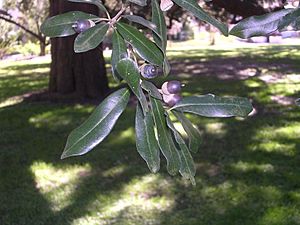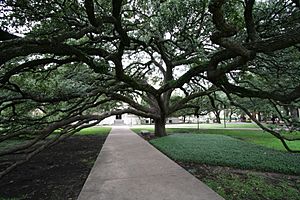Southern live oak facts for kids
Quick facts for kids Southern live oak |
|
|---|---|
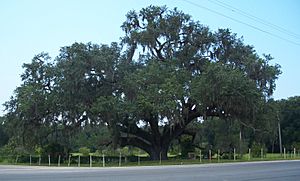 |
|
| The Volusia Oak on the St. Johns River in Volusia, Florida. | |
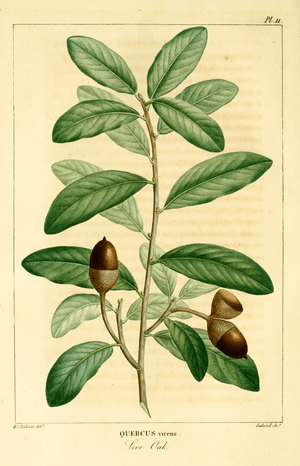 |
|
| 1812 illustration | |
| Conservation status | |
| Scientific classification | |
| Genus: |
Quercus
|
| Species: |
virginiana
|
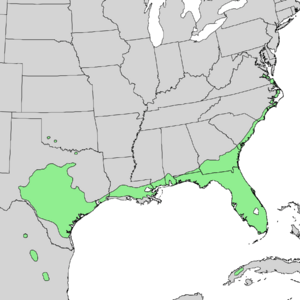 |
|
| Synonyms | |
|
List
Dryopsila virens (Aiton) Raf.
Quercus andromeda Riddell Quercus hemisphaerica Endl. Quercus phellos var. obtusifolia Lam. Quercus phellos var. sempervirens Marshall Quercus sempervirens Walter Quercus virens Aiton Quercus virginiana var. eximea Sarg. Quercus virginiana var. virescens Sarg. |
|
The Quercus virginiana, often called the southern live oak, is a special oak tree. It is an evergreen tree, which means it keeps its leaves all year round. This tree naturally grows in the Southeastern United States. While other trees are also called "live oaks," the southern live oak is a famous symbol of the Old South. You can find many very large and old southern live oaks in the Deep South part of the United States today.
Contents
What is a Southern Live Oak?
Different Names for the Southern Live Oak
This tree has many common names. People call it "Virginia live oak," "bay live oak," or "scrub live oak." In Spanish, it's known as "roble." Often, people in its native area just call it "live oak." However, using the full name "southern live oak" helps us tell it apart from other types of evergreen oak trees.
Scientists sometimes disagree on how to classify different live oaks. Some think certain types are their own species. Others believe they are just varieties of the Quercus virginiana. For example, the escarpment live oak and the sand live oak are sometimes seen as separate species. Other times, they are considered varieties of the southern live oak.
Southern live oaks can also mix with other oak species. This means they can create new types of trees by combining their genes. They can hybridize with trees like the dwarf live oak and the swamp white oak.
Where Do Southern Live Oaks Grow?
Native Range of the Southern Live Oak
You can find southern live oaks growing naturally along the lower coast of the Gulf of Mexico. They also grow along the lower East Coast of the United States. Their native range starts in southeast Virginia. From there, it goes south through North Carolina and into South Carolina.
As you go further south, the trees spread more inland. They grow across southern Georgia and almost all of Florida. They are found along the Florida panhandle and westward into Mississippi. The trees also grow across the southern part of Louisiana and into Texas. In Texas, their range stays close to the coast.
Some people think the southern live oak grows in Southwestern Oklahoma. However, those trees are usually the Escarpment Live Oak. This is a similar tree that can handle colder weather better.
Where Southern Live Oaks Thrive
Along the coast, live oaks grow in both single-species and mixed forests. They can be seen in savannas and in grasslands. These trees grow in many types of soil, from heavy clay to sandy soils. They do well where fires do not happen often.
Live oaks are found on higher ground and in hammocks within marshes and swamps. Generally, they stay close to the coastline. They are rarely found more than 300 feet above sea level. Live oaks can handle different moisture levels, from dry to moist. They can even survive short floods if the water drains well. Good soil drainage is very important for them to grow strong.
They usually need 25 to 65 inches of rain per year, especially in spring and summer. The soil they grow in is usually acidic, with a pH between 5.5 and 6.5. You can find some northernmost mature specimens in Annapolis, Maryland and Bowie, Maryland. Younger trees also grow around Towson and Baltimore.
What Do Southern Live Oaks Look Like?
Southern live oaks keep their leaves almost all year. However, they are not true evergreens. They drop their old leaves just before new ones grow in the spring. Sometimes, older leaves might turn yellow or get brown spots in winter. This is normal and does not mean the tree is sick.
The bark of the southern live oak is dark and thick. It has deep grooves running down it. The leaves are stiff and feel like leather. Their tops are shiny dark green, and their bottoms are pale gray. They are usually flat with smooth edges. Leaves are about 2 to 15 centimeters (0.75 to 6 inches) long. They are about 1 to 5 centimeters (0.4 to 2 inches) wide. They grow alternately along the branches.
The male flowers are green and hang down in strings called catkins. These are about 7.5 to 10 centimeters (3 to 4 inches) long. The acorns are small, about 1 to 2.5 centimeters (0.4 to 1 inch) long. They are oval-shaped and shiny, ranging from tan-brown to almost black. Acorns often have black tips and grow alone or in small groups.
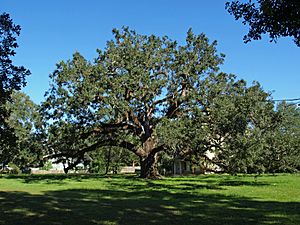
Southern live oaks can be small shrubs or large, wide-spreading trees. A typical tree growing in an open area can reach 20 meters (65.5 feet) tall. Its branches can spread out almost 27 meters (88.5 feet) wide. The lower branches often sweep down toward the ground before curving back up. They can grow at unusual angles. Long ago, Native Americans would bend young trees. This made them grow at extreme angles to mark trails.
Many other plants often grow on the branches of live oaks. These include rounded clumps of ball moss and long, thick strands of Spanish moss. You might also see resurrection fern and parasitic mistletoe growing on them.
The southern live oak has a deep main root when it is young. As it grows, it develops a wide root system. This, along with its low center of gravity, helps the tree resist strong winds. This is why they can survive hurricanes very well.
These trees grow strongly when they have plenty of moisture and good drainage. They can usually survive fires because the fire often does not reach their tops. Even if a tree burns, its roots and top parts usually survive and grow back. Live oak forests also help stop fires from spreading from nearby areas. This is because their dense cover prevents flammable plants from growing underneath. They can handle occasional floods and hurricanes. They are also resistant to salt spray and some salt in the soil. While they grow best in sandy soils, they can also grow in clay.
How Are Southern Live Oaks Used?
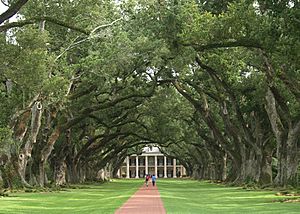
Historical Uses of Live Oak Wood
Live oak wood is very hard, heavy, and strong. It was difficult to work with, but its strength made it perfect for building wooden ships. Shipbuilders used the natural curves of the trunk and branches for the ship's frame. The famous ship USS Constitution was built using southern live oak wood. This wood was so dense that it could survive cannon fire. This earned the ship its nickname, "Old Ironsides." Even today, the U.S. Navy still owns large areas of live oak trees.
Modern Uses and Importance for Wildlife
Today, southern live oaks are mainly important for providing food and shelter for wildlife. Their acorns are a key food source for many animals. These include the bobwhite quail, the threatened Florida scrub jay, and the wild turkey. Black bears, different types of squirrels, and white-tailed deer also eat the acorns.
The tree's top is very dense, making it great for shade. Many animals also build their nests in these trees. Native Americans used live oaks in many ways. They made cooking oil from the acorns. They used all parts of the tree for medicine. Leaves were used to make rugs, and bark was used for dyes. The roots of young trees sometimes form starchy, edible tubers. In the past, people would harvest and fry these tubers, much like potatoes.
Growing Southern Live Oaks
Southern live oaks are grown in warmer places as beautiful trees or for shade. You can find them in the southern United States, parts of Mexico, Europe, and Australia. Growing them is quite easy. Young live oak trees grow fast if they have enough moisture in the soil. After a few years, they only need extra water sometimes.
Southern live oaks live for a very long time. Many trees in the southern United States are more than 400 years old. They can reliably grow in areas where the lowest winter temperature is around -9 to -7 degrees Celsius (15 to 20 degrees Fahrenheit). This means they can grow as far north as Atlanta and Memphis.
Famous Southern Live Oak Trees
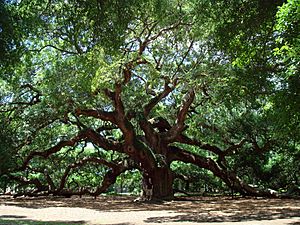
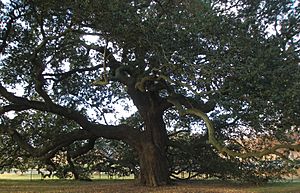
Many southern live oaks are famous because of their age, size, or history.
- The Seven Sisters Oak is thought to be between 500 and 1,000 years old. It is the largest certified southern live oak tree.
- The Angel Oak on Johns Island, South Carolina, is about 400-500 years old. It has a trunk that is 8.5 meters (28 feet) around. It is 20 meters (66 feet 6 inches) tall and its branches spread 57 meters (187 feet) wide.
- The Big Tree in Rockport, Texas, is about 1,000 years old. It is the largest live oak in Texas.
- The Boyington Oak in Mobile, Alabama, is about 180 years old. It is known for the interesting stories about how it started.
- The Cellon Oak in Florida is the largest recorded live oak in that state. It has a trunk that is 9.1 meters (30 feet) around. It is 25.9 meters (85 feet) tall and its branches spread 48.8 meters (160 feet) wide. It is even used as the logo for Alachua County, Florida.
- The Duffie Oak in Mobile, Alabama, is over 300 years old. It is the oldest living landmark in the city.
- The Emancipation Oak at Hampton University in Virginia is one of the "Ten Great Trees of the World." This was named by the National Geographic Society.
- The Century Tree, planted in 1891 at Texas A&M University, is a campus landmark. It has been called a Famous Tree of Texas.
- The Friendship Oak is a 500-year-old southern live oak. It is located at the University of Southern Mississippi in Long Beach, Mississippi.
- The Lover's Oak in Brunswick, Georgia, is estimated to be 900 years old.
- The Treaty Oak in Austin, Texas.
- The Treaty Oak in Jacksonville, Florida.
- The Bland Oak in Sydney, Australia, was planted in the 1840s. It is one of the oldest trees in the city and the largest oak tree in Australia.
- The Airlie Oak in Wilmington, North Carolina, dates back to about 1545. It is the largest Live Oak in North Carolina.
- The Big Oak in Thomasville, Georgia.
- The Baranoff Oak in Safety Harbor, Florida, is thought to be the oldest live oak in Pinellas County, Florida. It is estimated to be between 300-500 years old.
Images for kids
See also
 In Spanish: Quercus virginiana para niños
In Spanish: Quercus virginiana para niños



